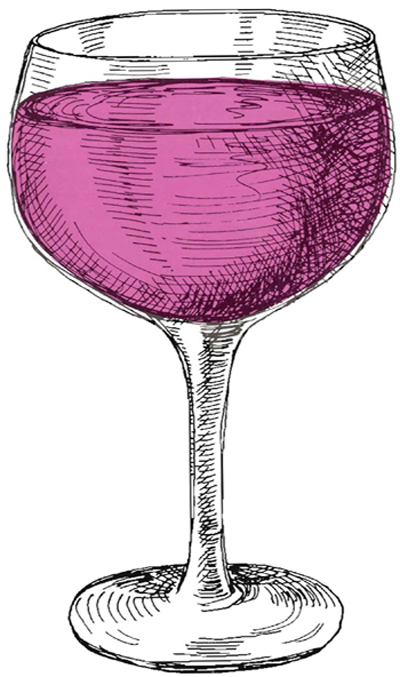
- Legal Obligations
- Equipment
- Ingredients
- Winemaking Process
- Wine Recipes
- Winemaking Supplies
- References
Wine can be made from any material capable of growing yeast. This process of active yeast growth on foodstuff is called alcoholic fermentation. The yeast feeds on the fruit sugar and converts it into ethyl alcohol and carbon dioxide gas. This process gradually depletes the sugar content as the percentage of alcohol increases. The distinct flavor and aroma of an individual wine comes from small quantities of other chemical substances produced during fermentation. In addition, the flavor and aroma are further enhanced by proper aging of the wine.
Fruits, berries and grapes readily support fermentation to produce wine. For this reason, they are the best sources to use in making wine. Many people, especially those having home fruit orchards, wild or cultivated grapes and berries growing on their property, have taken up home winemaking as a hobby. They have found it to be a challenging and rewarding diversion from the daily life routine.
This making of good quality wine involves more than just following granny’s recipes. Winemaking is a science and as such requires close attention to detail. Fermentation must be carefully controlled to avoid spoilage which renders the wine unpalatable. Cleanliness is essential in all phases of winemaking. If utensils are not thoroughly cleaned and sterilized, they may contaminate the wine. Ingredients, particularly the fruit, must be of high quality, free from decay and external contaminates.
The purpose in writing this bulletin is to provide essential material and detailed instructions for successfully making wine at home. The information described here is designed for beginners who do not know where to begin and for those experienced amateurs who frequently run into difficulties and disappointments.
Legal Obligations
IMPORTANT NOTE: Under federal law the head of a family is allowed to produce, for home consumption only, up to 200 gallons of wine annually without payment of tax. However, before starting to make beer one must file, in duplicate, copies of Form 1541 with the Internal Revenue Service Regional office. The address of the Southeast Regional office is:
Assistant Regional Commissioner
Internal Revenue Service
Alcohol and Tobacco Tax Division
Federal Office Building
275 Peachtree Street
Atlanta, Georgia 30303
Equipment
The equipment required for making wine depends a great deal upon the quantity to be processed during a given period of time. On the average, the home wine maker will only produce from one to five gallons at a time. A list of equipment and other supplies needed to make wine at home follows:
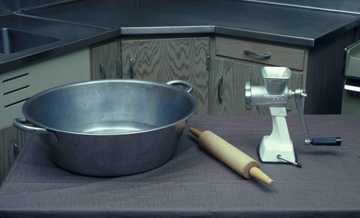 Rolling pin, or food grinder, or food chopper
Rolling pin, or food grinder, or food chopperA rolling pin, or food grinder, or food chopper is used to crush the fruit. Choppers with quarter-inch plates are ideal for crushing fruit without splitting the seeds.
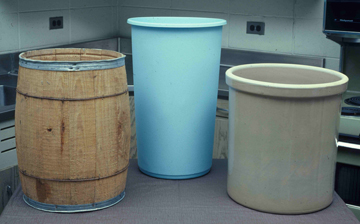 Primary fermentor
Primary fermentorA primary fermentor is a large (8 gallon) open container in which the ingredients are mixed and initial fermentation takes place. Food grade polyethylene containers are best to use because they are easy to clean and do not affect the taste of the wine. Glass or ceramic pots and stainless steel containers are heavy and difficult to handle. All other materials, especially aluminum and copper, should be avoided due to their toxicity. Wooden containers are acceptable but are difficult to keep clean.
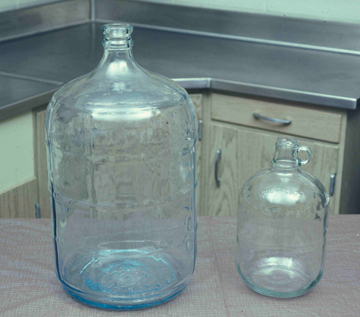 Secondary fermentor
Secondary fermentorA secondary fermentor is a smaller (1, 3 or 5 gallon) container having and opening only large enough to securely place a fermentation lock. Several sizes may be needed for wine making. These containers are made of heavy glass or high-density polyethylene. Fermenting juice is transferred to these containers one to seven days after the start of fermentation.
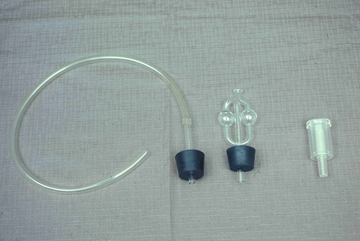 Fermentation lock
Fermentation lockA fermentation lock is a device attached to a rubber stopper which is designed to fit into the secondary fermentor. It is important for the device to be secured so carbon dioxide gas can escape from the fermentor without letting in any air. Air contact can spoil the wine by oxidation or can contaminate the wine with acetic bacteria. These bacteria convert the alcohol in the fermenting juice to vinegar. Several commercially made locks are available or one can be made with a one-hole stopper, glass tubing, and a length of rubber or plastic tubing as follows: Insert the piece of glass tubing in the stopper. Place both in the small opening of the fermentor. Attach one end of the hose to the exposed glass tubing and submerge the other end in a mason jar filled with cold water.
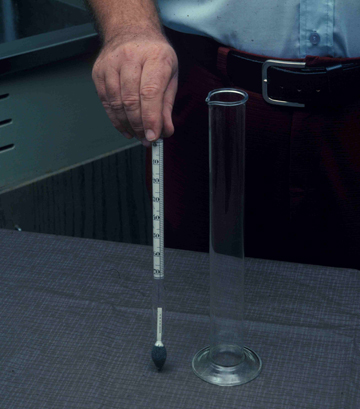 Hydrometer
HydrometerA hydrometer is a simple and inexpensive instrument which takes the guesswork out of winemaking. It is used to measure the amount of sugar in the fruit juice prior to fermentation. It also tells when fermentation is completed. A hydrometer is essential for consistent results in home winemaking. Its use is further explained in this publication. The hydrometer and cylinder are purchased as a set from a scientific supply house.
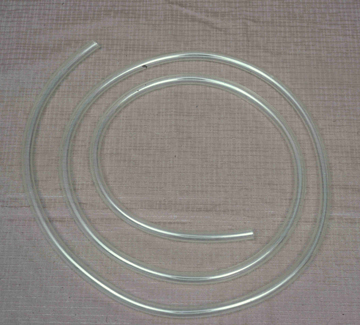 Siphoning unit
Siphoning unitA siphoning unit, 3/8-inch diameter rubber hose or plastic tubing which is five to six feet long, is commonly used to transfer wine from one container to another (racking), and finally into the bottles. The best flow rate is achieved when the upper container is about 18-inches above the lower container.
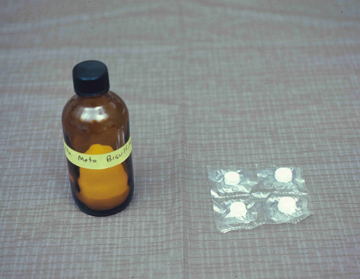 Campden tablets or potassium metabisulfite
Campden tablets or potassium metabisulfiteCampden tablets or potassium metabisulfite are used as a source of sulfur dioxide to check the growth of wild yeast and vinegar bacteria in the fermenting juice or finished wine. These agents also protect the color and flavor of the wine.
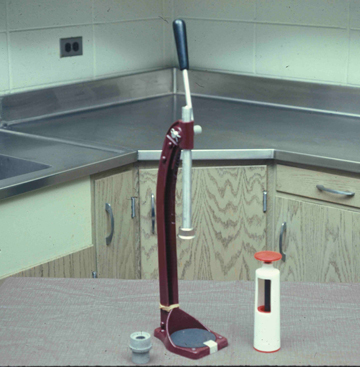 Wooden hand corker
Wooden hand corkerA wooden hand corker, or mallet, and size no. 9 cork are used in corking standard wine bottles. The corks must be sterilized before insertion. Submerge the corks in a solution containing two quarts hot water and ½ level teaspoon potassium metabisulfite or 4 Campden tablets for 15 minutes.
Rinse and soak them in fresh tap water an additional 15 minutes. Rinse and allow excess water to drain off, then drive the softened corks into filled bottles with a mallet or corker allowing a 3/8-inch headspace. After corking, store the bottles in an upright position for one week to allow time for the corks to harden. Then turn the bottles on their side to keep the corks moist and store the bottles at 60º F.
Standard wine bottles with screw tops or standard size champagne bottles with plastic corks are good for holding wine. These can be obtained at restaurants. It is best to use plastic bottles that are tinted since light affects the color of some wines. If tinted bottles are not available, use clear glass, but store them in a dark place.
Clean and sterilize used wine bottles with hot water and a weak solution of bleach (1 tablespoon bleach to a gallon of water). Screw caps and plastic corks are sterilized using potassium metabisulfite.
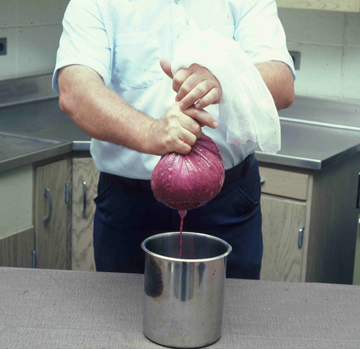 Pressing bag or straining cloth
Pressing bag or straining clothA pressing bag or straining cloth is needed to separate the fruit pulp solids from the liquid. A burlap or well-sewn canvas bag, 12-inches wide by 14-inches deep, is best for straining. However, having nothing better, cheesecloth or a diaper can be stretched over a “food grade” polyethylene bucket or stainless steel mixing bowl. Clothespins can be used to hold the straining cloth in place when the fruit pulp and juice are poured into the container. Remember to wash and sterilize straining bags and cloth before use.
Miscellaneous items which will be needed include: a large saucepan, a long-handled plastic spoon, a measuring cup and a set of measuring spoons, masking tape or pieces of rope, a funnel, extra cheesecloth, also gummed labels, a marking pen, a long-handled brush for cleaning, and bathroom or platform type scales for weighing juice.
Ingredients
Fruit
The maturity and condition of the fruit being used for fermentation is very important in winemaking. Green fruit is generally high in acid and low in sugar content. Fruit of this type gives a tartness to wine, lacking a true fruity flavor. Fully ripe fruit is at its lowest acid and highest sugar content, and this is when fruit is at its best for winemaking, for it leaves a pleasant fruit flavor to the finished wine. Sound, firm fruit will contain most of the supplements necessary to complete the fermentation process. Over-ripe or bruised fruit has begun to mold and decay even though it may not be noticeable. If fruit of this type is used, a disagreeable flavor will result.
Yeast
Flavor and taste of the finished wine is largely determined by the type of yeast used in fermentation. For best results, use only a true wine yeast such as Montrachet No. 522, which is available from wine supply houses. An acceptable second choice is Baker’s yeast. Yeasts are living organisms and as such require a balanced diet for proper development. The muscadine grape, when properly grown, is one of the few fruits containing all the necessary food supplements for yeast growth. Most other fruits are lacking in some part of the yeast requirements, even some wine grapes. A balanced yeast food known as nutrient must be added with the yeast at the start of fermentation. Yeast nutrient is commercially available at wine supply houses. Good substitutes for this nutrient include a pinch of ammonium phosphate (commercial fertilizer) or a small handful of minced raisins per gallon of crushed fruit.
Acid
Fruits vary a great deal in their acid content or tartness. Lack of acid gives wine an insipid taste while too much acid gives a sharp tang and can affect fermentation. Correct wine acidity brings out the full flavor of the fruit. Acid strength in the juice should be from one-half to three-fourths of one percent. Grapes are high in tartaric acid and usually the finished grape wine has this desired acidity. Some, such as apple wine, are low in acidity and require the addition of citric acid or some lemon juice to the fruit juice before fermentation begins to improve the flavor. Add approximately one tablespoon lemon juice per gallon strained juice or pulp.
Tanninn
Tannin gives wine its bite or astringency to overcome the greatest fault in wine, that of insipidness or flatness. Pears and grapes contain sufficient tannin in the skins and stems for winemaking, however, many other fruits including all white wines are lacking in tannin. To give wine its proper astringency, tannin must be added to these wines. Powdered tannin can be purchased commercially at wine supply houses with directions for its use. If tannin is not readily available, add several tablespoons of strong tea to the fermenting crushed fruit to improve the astringency of the finished wine.
Sugar
The amount of sugar used controls the sweetness of the wine and at the same time is directly responsible for its alcohol content. Sugar, when fermented, gives one-half its amount of alcohol by volume. Thus, when completely fermented, a fruit having 22 percent sugar (fruit sugar plus added sugar) will give a wine with 11 percent alcohol. Wine containing less than 10 percent alcohol content will be thin and sour and will not keep. Under normal circumstances most yeasts have difficulty completing fermentation at sugar levels above 24 percent. Hence any sugar content in excel of 24 percent is going to remain in the finished product, resulting in sweet wine.
Sugar used in winemaking can be either ordinary household sugar or corn sugar also known as dextrose. Dextrose can be purchased at wine supply houses and is said to produce smoother wine when large amounts of sugar are needed. Sugar is best added to the raw juice in the form of sugar syrup, prepared by dissolving two cups sugar in one cup boiling water. One cup of sugar syrup is then equivalent to a 50 percent sugar solution. Adding several cups of sugar syrup every few days until the total sugar requirement has been met is the best method of keeping a good strong fermentation in progress.
Gelatin
Ordinarily, a wine of good alcoholic strength will clear itself if allowed to stand. But it sometimes happens, after several rackings, that a wine apparently good in other respects refuses to clear up properly. These wines may be artificially clarified using powdered kitchen gelatin. Measure out one level teaspoon gelatin for every five gallons wine. Add the gelatin to about a quart of drawn wine and dissolve by warming to 100º F while mixing well. Return this quart to the original bulk of wine and stir for 10 minutes, seal and let stand until wine clears. Since the gelatin settles tannin, along with other impurities, it is necessary to add tannin (amount equal to that of gelatin used) back to the wine.
The Winemaking Process
Step 1 — Cleaning
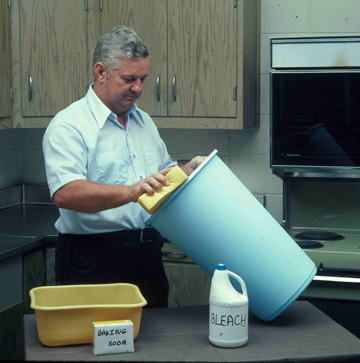 Step 1. Cleaning
Step 1. CleaningClean all winemaking equipment and bottles thoroughly before starting an operation. Don’t use soap or detergents as their residues can impart an off-taste to the wine. Use hot water and a long-handled stiff brush to clean primary and secondary fermentors and bottles. To remove the industrial film off polyethylene, fill the container with hot water and add a pound of baking soda; then let set several hours before rinsing. After cleaning, swirl a weak bleach solution (1/4 cup bleach per gallon of water) in the containers to disinfect them. Use hot water to rinse through the siphon hose.
Step 2 – Preparing the Fruit
To begin, remove stems and unripe fruit. Trim or remove all rotten fruit. Rinse the fruit with cool water and allow to drain in a colander. Crush the fruit in order to free the juice for fermentation. Soft fruits such as berries and grapes can best be handled by spreading a thin layer in the bottom of a large flat sauce pan and crushing them with a rolling pin or potato masher. Much better results are obtained with solid fruits, such as apples, when they are crushed in a food chopper.
NOTE: If white wine is desired, the juice is immediately separated from the fruit skins and pulp using a pressing bag or straining cloth and transferred to the secondary fermentor. For red wine, transfer the entire contents (juice, pulp, skins) to the primary fermentor.
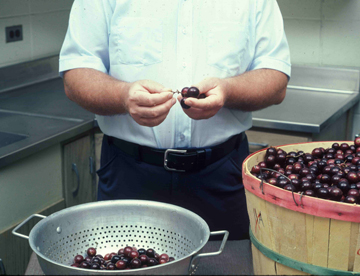 Step 2-1. Preparing the fruit
Step 2-1. Preparing the fruit Step2-2. Preparing the frui
Step2-2. Preparing the frui Step2-3. Preparing the fruit
Step2-3. Preparing the fruitStep 3 – Determining Sugar Content
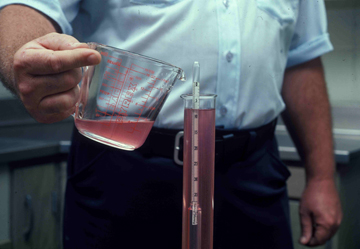 Step 3. Determining sugar content
Step 3. Determining sugar contentThe sugar content present in the juice prior to fermentation must be measured in order to know the exact amount of sugar needed to increase the level to 22 percent. To measure sugar content with a hydrometer, fill the glass cylinder with a sample of strained juice and immerse the heavy end of the hydrometer in it. Put the jar on a level surface and let the hydrometer ride in the juice until it becomes perfectly still. When it comes to rest, away from the sides of the cylinder, read the value at the surface of the liquid (not the part of the liquid which has climbed up the side of the instrument). Record this figure immediately so it will not be forgotten! The temperature of the juice should be about 75º F when the reading is taken.
Step 4 – Sterilizing Fruit
Dissolve either four Campden tablets or one-half teaspoon potassium metabisulfate in a pint of strained juice. Add this back to either the primary fermentor containing crushed fruit or to the secondary fermentor containing strained juice. Mix thoroughly, cover the container with double layered cheesecloth, secure in place with a rope, and wait four hours before proceeding to Step 5.
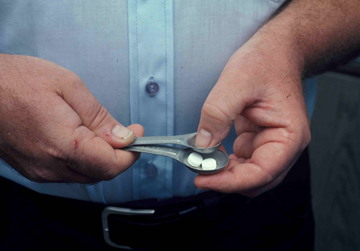 Step 4-1. Sterilizing fruit
Step 4-1. Sterilizing fruit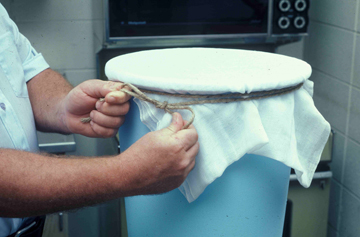 Step 4-2. Sterilizing fruit
Step 4-2. Sterilizing fruitStep 5 – Adding of Nutrients
For fruits, other than grapes, add sufficient tannin (tea), citric acid (lemon juice), yeast nutrient (raisins) and sugar syrup to either the crushed fruit or strained juice as called for in the recipe.
Step 6 – Activating Wine Yeast
Activate a package of wine yeast (or Baker’s yeast as the second choice) by dissolving it in a cup of strained juice. Add this to the crushed fruit or strained juice and mix well.
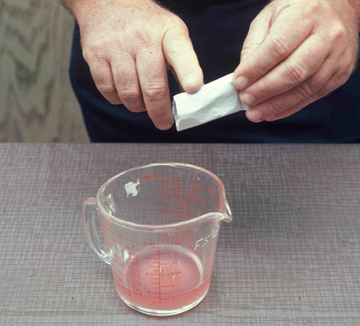 Step 6-1. Activating wine yeast
Step 6-1. Activating wine yeast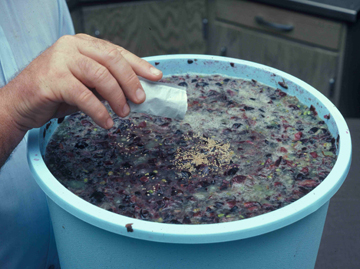 Step 6-2. Activating wine yeast
Step 6-2. Activating wine yeastStep 7 – Extracting Color for Red Wine
Cover the primary fermentor containing the crushed fruit with double layered cheesecloth, secure in place with a rope, and store in a warm place (60-70º F) such as a cellar or basement. Fermentation should begin within 24 hours. By the second day, the pulp should be in strong ferment. The solids in the pulp will float to the surface to form a cap over the fermenting juice.
At least twice a day this cap should be stirred thoroughly into the juice, always replacing the cover. It is most important that the fermenting pulp and juice be protected from small vinegar flies and other insects by covering during this period. Allow the fruit pulp to ferment from three to seven days in order to extract the desired color from the skins.
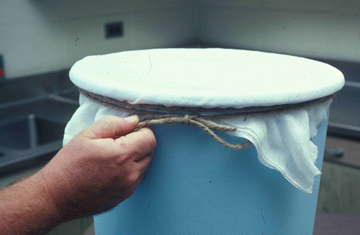 Step 7-1. Extracting color for red wine
Step 7-1. Extracting color for red wine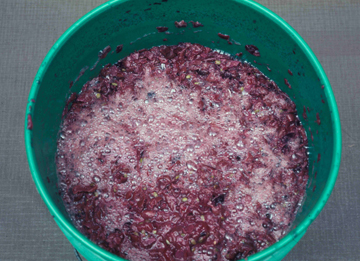 Step 7-2. Extracting color for red wine
Step 7-2. Extracting color for red wineStep 8 – Straining Fruit Pulp
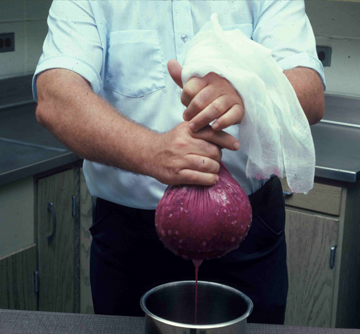 Step 8. Straining fruit pulp
Step 8. Straining fruit pulpUsing a pressing bag or several layers of cheesecloth, squeeze or strain the solids from the fermenting juice into a large saucepan. It is best to strain off the clear liquid first by holding back the surface solids, then gather the remaining solids in the bag or cloth and squeeze dry by slowly applying pressure. Do not squeeze hard enough to force pulp through the cloth and into the juice. Transfer the contents to the secondary fermentor using a plastic funnel to avoid spillage.
Step 9 – Determining Sugar Needed
The amount of sugar required to raise the sugar level of the juice to 22 percent can be calculated by a formula called the Pearson Square. It is diagramed below.
An example of how to use this formula for making five gallons of wine is as follows:
A sample of strained peach juice, drawn from a bushel of freshly crushed peaches was found to contain 10 percent sugar (value read at liquid’s surface when tested with a hydrometer). After primary fermentation to extract color, 35 pounds of fermenting juice – determined by the difference between fermentor weight and fermentor weight + juice weight – were separated from the skins, seeds, and pulp. How much sugar (cups sugar syrup) should be added to the 35 pounds of juice to increase the initial sugar level of the juice from 10 to 22 percent?
To begin:
- Place in the upper left-hand corner or a square the percent of sugar in the syrup. Syrup prepared at a rate of two cups sugar to one cup water contains 50 percent sugar.
- In the lower left-hand corner place the percent of sugar (10) in the strained juice.
- In the center of the square place the percent of sugar level (22) desired.
- Now subtract the center figure from the figure in the upper left-hand corner, and place the remainder in the lower right-hand corner (50 – 22 = 28).
-
Subtract the figure in the lower left-hand corner from the figure in the center and place the remainder in the upper right-hand corner (22-10 = 12).
This last figure (12) is the number of cups of a 50 percent sugar syrup which must be added to 28 pounds of juice to increase the sugar level from 10 to 22 percent. But in this example, there are 35 pounds of juice. Therefore, to determine the number of cups of syrup required, simply divide the total pounds of juice (35) by the number in the lower right-hand corner of the square (28) and multiply by the number in the upper right-hand corner (12). First, divide 35 by 28 (= 1.25), the multiply the quotient by 12 (1.25 x 12 = 15). The result (15) will be the number of cups of sugar syrup which must be added to 35 pounds of juice to increase the sugar level from 10 to 22 percent.
Step 10 – Fermenting Red Wine
Dissolve the sugar required in water at a rate of two cups sugar to one cup water. Sterilize by brining to a rolling boil for a few minutes before setting aside to cool to room temperature. Add several cups of the sugar syrup to the fermenting juice and swirl gently to distribute. Don’t add the entire sugar syrup solution to the fermenting juice because it may cause excessive bubble formation, resulting in overflow. Adding all the syrup may also stun or kill the yeast producing an inferior wine of low alcohol strength.
Next, seal the fermentor with a snug-fitting fermentation lock and set this container in a place having a constant temperature of between 60-70º F. Within a day or two, carbon dioxide bubbles will be seen steadily emerging from the fermentation lock, an indication that active fermentation has begun. Fermentation must be vigorous so that the heavier than air carbon dioxide gas produced will lie on top of the juice like a blanket to stop the yeast from obtaining oxygen from the air. Carefully remove the lock and add two cups sugar syrup, then quickly and securely replace the lock back in place on the fermentor. Gently swirl the container to dissolve the syrup. Repeat this process every four to five days or until the solution is entirely used. Fermentation will proceed about a month.
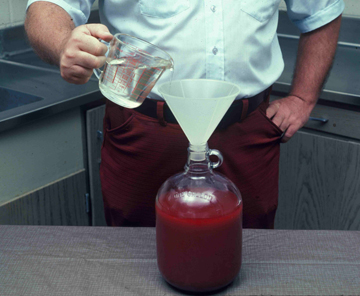 Step 10-1. Fermenting red wine
Step 10-1. Fermenting red wine Step 10-2. Fermenting red wine
Step 10-2. Fermenting red wine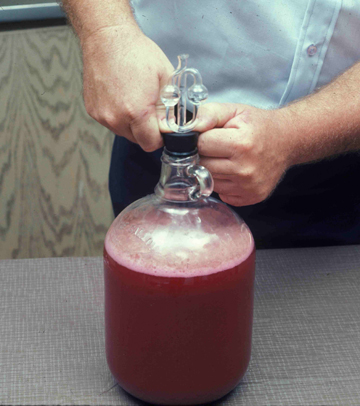 Step 10-3. Fermenting red wine
Step 10-3. Fermenting red wine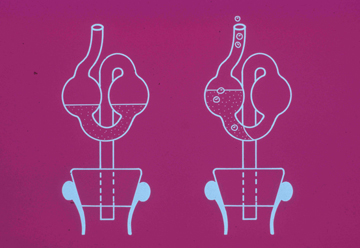 Step 10-4. Fermenting red wine
Step 10-4. Fermenting red wineStep 11 – Fermenting White Wine
If fruit juice only had been used, there should be no solids to strain out and the liquid would have been placed into the secondary fermentor. While the strained juice is being sterilized, dissolve the sugar required in water, sterilize and cool as before. Follow the same recommendations for adding sugar as were stated for making red wine. Store the container at a temperature of between 60-70º F until fermentation almost ceases.
Step 12 – Racking the Wine
During the process of fermentation, a whitish, fine sediment, comprised mainly of dead yeast cells, is deposited on the bottom of the secondary fermentor. Racking is the process designed to separate the wine from this sediment and is performed by siphoning the wine from one container to another when fermentation has practically come to a stop. Using a chair or table, place the secondary fermentor 18 inches above the tope of a cleaned and sterilized five-gallon fermentor located on the floor. Insert a rubber hose approximately three-eights-inch in diameter and about five feet long into the secondary fermentor. Siphon the wine from this upper container into the lower one taking care not to stir up the sediment.
During this first racking, allow the wine to aerate slightly by falling from the middle of the container to the bottom. This oxygen is utilized by the remaining yeasts in the wine to complete the fermentation process. Add one-eighth-teaspoon potassium metabisulfite or one Campden tablet for every three gallons of siphoned wine to prevent spoilage. Replace the fermentation lock and wait a month before the next racking in order for fermentation to run to completion.
Some wines continue a very slow fermentation for several months and remain cloudy. They may require racking three or four times before they become sparkling clear and are ready for bottling. In each case, racking should be done without aeration, that is, the siphoning hose should be submerged below the liquid in the lower container to keep air out of the wine.
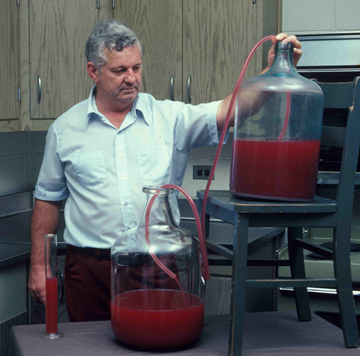 Step 12-1. Racking the wine
Step 12-1. Racking the wine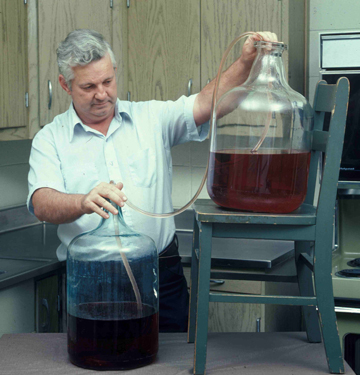 Step 12-2. Racking the wine
Step 12-2. Racking the wine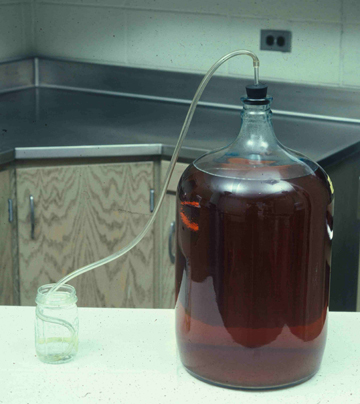 Step 12-3. Racking the wine
Step 12-3. Racking the wine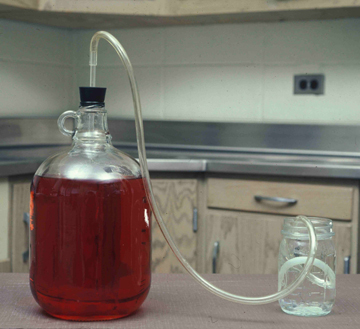 Step 12-4. Racking the wine
Step 12-4. Racking the wineStep 13 – Clarifying the Wine – Optional
The chilling (30-40º F) of grape wine, after racking, prompts the natural clarification of this wine. Unwanted matter and suspended solids including potassium bitartrate, are precipitated as crystals in the bottom of the container. Other wines can be treated with gelatin if they will not clear under any circumstances. The gelatin combines with tannin present in the mix to form a milky colored solution. This will in turn settle slowly, dragging down any suspended materials to the bottom of the fermentor. It will take about a month for the wine to clarify, after which it is siphoned from the sediment. The disadvantage of using this treatment is that tannin, which gives wine its unique taste, is removed. It is necessary then to mix tannin back into the wine using approximately the weight of gelatin needed to initiate clarification.
Step 14 – Bottling the Wine
When fermentation has completely stopped, the wine should be sparkling clear and ready to bottle. Wine should be siphoned without aeration into bottles for aging. This limits the chance of off-flavor and off-color development due to oxidation.
Also, dissolve one-eighth-teaspoon potassium metabisulfite or one Campden tablet for every three gallons of wine in the fermentor prior to siphoning into bottles to prevent bacterial spoilage. An inexpensive hand corker, which is driven by a mallet, can be used to drive corks into wine bottles. In addition, a small corking machine operated by levers can be used to compress corks into the bottles. If screw-tops or plastic tops are used, cap the bottles loosely the first day of filling to allow residual gases to escape. Next day, tighten them in place.
Once wine has been bottled, each bottle should be labeled giving information as to its sweetness, flavor, clarity, etc. Also, a file or notebook should be kept on winemaking procedures so fine adjustments can be made from one year’s production to another in order to produce wines exactly as you would like to have them.
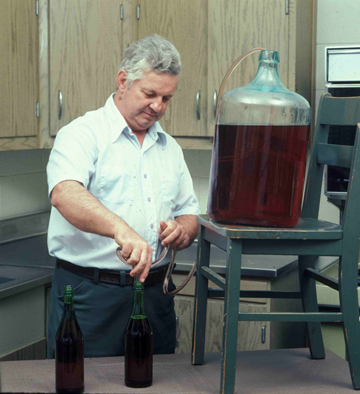 Step 14-1. Bottling the wine
Step 14-1. Bottling the wine 2. Bottling the wine
2. Bottling the wine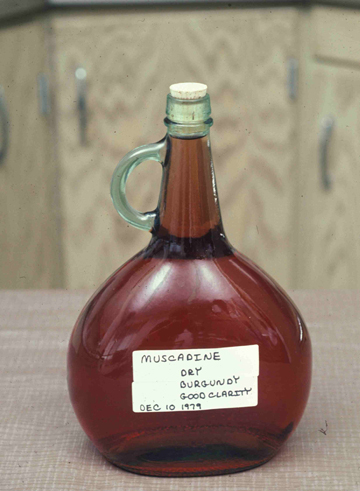 Step 14-3. Bottling the wine
Step 14-3. Bottling the wineStep 15 – Storing the Wine
Wines age best at an even 60º F temperature. A clean, dry basement shielded from light is an ideal place for wine storage. Wine should be stored on its side to keep the cork moist and to prevent the entrance of spoilage bacteria. During aging, subtle changes in the flavor of wine take place contributing to each wine’s characteristic bouquet and appeal. Sedimentation may take place with aging. If sediment does occur, carefully decant the clear wine to a clean bottle before serving.
Wine can be consumed anytime after bottling; however, increased aging will mellow and bring out the unique flavors of the wine. For superior clarity and flavor, wine must be aged about a year before consumption.
Wine Recipes
A wine recipe can be nothing more than a basic guide to making wine. This is due to the variables that occur in the composition of a specific fruit when grown under varying climatic, soil, and seasonal conditions. Generally, hot, dry weather will produce more sugar in a fruit, while cool, damp weather tends to increase the acidity. In addition, the degree of fruit maturity affects its sugar-acid ration, riper fruit being higher in sugar content and green fruit being more acidic. These are some of the factors that must be considered in formulating an acceptable wine recipe.
Some selected fruit recipes which will make both dry and sweet wines follow. For consistent results in making good quality dry wines, a hydrometer should be used to measure critical sugar needs; much more sugar than the critical amount will produce a sweet wine. To prevent bacterial spoilage, wines must have 11 percent alcohol content. If a sweet wine is desired, a simple method for determining sweetness is to taste the wine when fermentation stops; then add enough sugar syrup to make the wine as sweet as desired prior to racking.
| Blackberry or Blueberry Wine (Dry) | |
|
2 ½ |
gallons of fresh, ripe berries |
|
15-20 |
cups sugar syrup (approximately) |
|
6 |
Campden tablets |
|
1 |
package wine yeast |
|
8 |
ounces lemon juice |
|
5 |
ounces minced raisins |
|
Thoroughly mash fruit in a large container; measure and record sugar content of strained juice with hydrometer. Crush and add four Campden tablets to the container, cover with cheesecloth, and let stand four hours at room temperature. Add five cups sugar syrup, lemon juice and yeast to container, cover and allow to ferment seven days at 60-70º F, stirring pulp thoroughly twice daily. Strain pulp, place juice in secondary fermentor and weigh. Use formula to calculate number of cups syrup needed (be sure to deduct 5 cups from this number); then add five additional cups syrup, minced raisins, attach fermentation lock and store at 60º F. Add quickly two and one-half cups sugar syrup every four or five days until all the syrup has been added. Fermentor should be 95 percent full to prevent oxidation of wine. When fermentation has almost stopped, rack wine into clean fermentor, add one Campden tablet, replace lock and let stand a month to clear. If not clear after this time, rack again, adding one Campden tablet; bottle, label and store at 60º F for aging. |
|
| Blackberry or Blueberry Wine (Sweet) | |
|
5 |
gallons of fresh, ripe berries |
|
35 |
cups sugar syrup |
|
6 |
Campden tablets |
|
1 |
package wine yeast |
|
5 |
ounces minced raisins |
|
Thoroughly mash fruit, add four crushed Campden tablets, cover with cheesecloth and allow container to stand four hours at room temperature. Add 15 cups sugar syrup, yeast and allow to ferment five days at a temperature between 60-70º F, stirring pump thoroughly twice daily. Strain off pulp and place juice in secondary fermentor; add 10 more cups sugar syrup and minced raisins, attach fermentation lock and store at 65º F. Every four or five days, quickly add two and one-half cups sugar syrup until all syrup has been added. When fermentation has nearly stopped, rack wine in clean fermentor; add one crushed Campden tablet, replace lock and let stand a month to clear. If wine is not clear after this time, rack a second time, add one Campden tablet, bottle label, and store at 60º F for aging. |
|
| Raspberry or Strawberry Wine (Dry) | |
|
2 ½ |
gallons of fresh, ripe berries |
|
15-20 |
cups sugar syrup (approximately) |
|
6 |
Campden tablets |
|
1 |
package wine yeast |
|
5 |
ounces minced raisins |
|
5 |
tablespoons strong tea |
|
8 |
ounces lemon juice |
| Thoroughly mash fruit in large container; measure and record sugar content of strained juice with hydrometer; crush and add four Campden tablets to the container, cover with cheesecloth and let stand four hours at room temperature. Add five cups sugar syrup, lemon juice and yeast to container, cover and allow to ferment seven days at a temperature between 60-70º F, stirring thoroughly twice daily. Strain pulp, place juice in secondary fermentor and weigh; use formula to calculate number of cups syrup needed (be sure to deduct 5 cups from this number). Then add five additional cups syrup, minced raisins and tea, attach fermentation lock and store at 65º F; every four or five days, quickly add two and one-half cups sugar syrup until all syrup has been added. Fermentor should be 95 percent full to prevent oxidation of the wine. When fermentation has almost stopped, rack wine into clean container, add one crushed Campden tablet, replace lock and let stand a month to clear. If not clear after this time, rack again, adding one Campden tablet; bottle, label and store at 60º F for aging. | |
| Raspberry or Strawberry Wine (Sweet) | |
|
5 |
gallons of fresh, ripe berries |
|
35 |
cups sugar syrup (approximately) |
|
6 |
Campden tablets |
|
1 |
package wine yeast |
|
5 |
ounces minced raisins |
|
5 |
tablespoons strong tea |
|
8 |
ounces lemon juice |
|
Thoroughly mash fruit, add four crushed Campden tablets, cover with cheesecloth and allow container to stand four hours at room temperature. Add 10 cups sugar syrup, lemon juice, tea and yeast and allow seven days to ferment at a temperature between 60-70º F, stirring thoroughly twice daily. Strain off pulp and place juice in secondary fermentor; add 10 more cups sugar syrup and minced raisins, attach fermentation lock and store at 65º F. Every four or five days, quickly add two and one-half cups sugar syrup until all syrup has been added. When fermentation has nearly stopped, rack wine in clean fermentor; add one crushed Campden tablet, replace lock and let stand a month to clear. If wine is not clear after this time, rack a second time, add one Campden tablet, bottle label, and store at 60º F for aging. |
|
| Apple or Crabapple Wine (Dry) | |
|
2½ |
gallons juice from fresh, ripe apples |
|
15-20 |
cups sugar syrup (approximately) |
|
6 |
Campden tablets |
|
1 |
package wine yeast |
|
3 |
ounces minced raisins |
|
8 |
ounces lemon juice |
|
Peel, core and quarter only fresh, ripe apples; grind in a food chopper to extract the juice. Measure and record sugar content of strained juice with hydrometer. If necessary, strain juice into large container, crush and add four Campden tablets, cover with cheesecloth, and allow contents to stand four hours at room temperature. Transfer juice to clean secondary fermentor and weigh; use formula to calculate number of cups syrup needed; add raisins, lemon juice, yeast and five cups sugar syrup to fermentor, attach fermentation lock and store at 65º F. Every three or four days, quickly add five additional cups sugar syrup and repeat this process until all the syrup has been added. The fermentor should be 95 percent full to prevent oxidation of wine. When fermentation has almost stopped, rack wine into clean fermentor, add one crushed Campden tablet, replace lock and let stand a month to clear. If not clear after this time, rack again, adding one Campden tablet; bottle, label and store at 60º F for aging. |
|
| Apple or Crabapple Wine (Sweet) | |
|
2 ½ |
gallons juice from fresh, ripe apples |
|
35 |
cups sugar syrup (approximately) |
|
6 |
Campden tablets |
|
1 |
package wine yeast |
|
3 |
ounces minced raisins |
|
8 |
ounces lemon juice |
|
Peel, core and quarter only fresh, ripe apples; grind in a food chopper to extract the juice. If necessary, strain juice into large container, crush and add four Campden tablets, cover with cheesecloth, and allow contents to stand four hours at room temperature. Transfer juice to clean secondary fermentor and add raisins, lemon juice, yeast and ten cups sugar syrup to fermentor, attach fermentation lock and store at 65º F. Every three or four days, quickly add five additional cups sugar syrup and repeat this process until all the syrup has been added. When fermentation has almost stopped, rack wine into clean fermentor, add one crushed Campden tablet, replace lock and let stand a month to clear. If not clear after this time, rack again, adding one Campden tablet; bottle, label and store at 60º F for aging. |
|
| Peach or Plum Wine (Dry) | |
|
2 ½ |
gallons fresh fruit |
|
15-20 |
cups sugar syrup (approximately) |
|
6 |
Campden tablets |
|
1 |
package wine yeast |
|
8 |
ounces lemon juice |
|
20 |
tablespoons strong tea |
|
3 |
ounces minced raisins |
|
5 |
cups boiled and cooled water |
|
Deseed and mash fruit with a food chopper. Measure and record sugar content of strained juice with hydrometer. Crush four Campden tablets and add to container of fruit, cover with cheesecloth and let stand four hours at room temperature. Add five cups sugar syrup and yeast to container, cover and allow to ferment six days as a temperature between 60-70º F, stirring pulp thoroughly twice daily. Strain pulp, place juice in secondary fermentor and weigh. Use formula to calculate number of cups syrup needed (be sure to deduct 5 cups from this number). Add five additional cups syrup, lemon juice, tea, raisins and five cups boiled and cooled water. Attach fermentation lock and store at 65º F. Every four or five days, quickly add five cups sugar syrup and repeat this process until all the syrup has been added. The fermentor should be 95 percent full to prevent oxidation of wine. When fermentation has almost stopped, rack wine into clean container, add one crushed Campden tablet, replace lock and let stand a month to clear. If not clear after this time, rack again, adding one Campden tablet; bottle, label and store at 60º F for aging. |
|
| Peach or Plum Wine (Sweet) | |
|
2 ½ |
gallons fresh fruit |
|
35 |
cups sugar syrup (approximately) |
|
6 |
Campden tablets |
|
1 |
package wine yeast |
|
8 |
ounces lemon juice |
|
20 |
tablespoons strong tea |
|
3 |
ounces minced raisins |
|
5 |
cups boiled and cooled water |
|
Deseed and mash fruit with a food chopper. Crush four Campden tablets and add to container of fruit, cover with cheesecloth and let stand four hours at room temperature. Add ten cups sugar syrup and yeast to container, cover and allow to ferment six days as a temperature between 60-70º F, stirring pulp thoroughly twice daily. Strain pulp, place juice in secondary fermentor and add five additional cups syrup, lemon juice, tea, raisins and five cups boiled and cooled water. Attach fermentation lock and store at 65º F. Every four or five days, quickly add five cups sugar syrup and repeat this process until all the syrup has been added. When fermentation has almost stopped, rack wine into clean container, add one crushed Campden tablet, replace lock and let stand a month to clear. If not clear after this time, rack again, adding one Campden tablet; bottle, label and store at 60º F for aging. |
|
| Pear Wine (Dry) | |
|
2 ½ |
gallons mashed, fresh, ripe fruit |
|
15-20 |
cups sugar syrup (approximately) |
|
6 |
Campden tablets |
|
1 |
package wine yeast |
|
8 |
ounces lemon juice |
|
3 |
ounces minced raisins |
|
5 |
cups boiled and cooled water |
|
Quarter and thoroughly mash fruit with a food chopper. Measure and record sugar content of strained juice with hydrometer. Crush four Campden tablets and add to container of juice, cover with cheesecloth and let stand four hours at room temperature. Add five cups sugar syrup and yeast to container, cover and allow to ferment two days as a temperature between 60-70º F, stirring pulp thoroughly twice daily. Strain off pulp and place juice in secondary fermentor and weigh. Use formula to calculate number of cups syrup needed (be sure to deduct 5 cups from this number). Add five additional cups syrup, lemon juice, raisins and five cups boiled and cooled water. Attach fermentation lock and store at 65º F. Every four or five days, quickly add two and one-half cups sugar syrup and repeat this process until all the syrup has been added. The fermentor should be 95 percent full to prevent oxidation of wine. When fermentation has almost stopped, rack wine into clean container, add one crushed Campden tablet, replace lock and let stand a month to clear. If not clear after this time, rack again, adding one Campden tablet; bottle, label and store at 60º F for aging. |
|
| Pear Wine (Sweet) | |
|
2 ½ |
gallons mashed, fresh, ripe fruit |
|
30 |
cups sugar syrup (approximately) |
|
6 |
Campden tablets |
|
1 |
package wine yeast |
|
8 |
ounces lemon juice |
|
3 |
ounces minced raisins |
|
5 |
cups boiled and cooled water |
|
Quarter and thoroughly mash fruit with a food chopper and place in large container. Crush and add four Campden tablets add to container, cover with cheesecloth and let stand four hours at room temperature. Add ten cups sugar syrup and yeast to container, cover and allow to ferment two days as a temperature between 60-70º F, stirring pulp thoroughly twice daily. Strain off pulp and place juice in secondary fermentor. Add five additional cups syrup, lemon juice, raisins and five cups boiled and cooled water. Attach fermentation lock and store at 65º F. Every four or five days, quickly add five cups sugar syrup and repeat this process until all the syrup has been added. When fermentation has almost stopped, rack wine into clean container, add one crushed Campden tablet, replace lock and let stand a month to clear. If not clear after this time, rack again, adding one Campden tablet; bottle, label and store at 60º F for aging. |
|
| Muscadine Grape Wine (Dry) | |
|
8 |
gallons fresh, ripe berries |
|
5 |
pounds sugar (approximately) |
|
6 |
Campden tablets |
|
1 |
package wine yeast |
|
For a red wine, use dark-skinned varieties such as “Hunt” or “Cowart”, and for a white wine, use light-skinned varieties such as “Scuppernong” or “Carlos”. Thoroughly mash fruit in a large container. Measure and record sugar content of strained juice with hydrometer. Crush four Campden tablets and add to container of juice, cover with cheesecloth and let stand four hours at room temperature. Activate yeast by suspending in a cup of warm water, add to container, cover and let stand four hours at a temperature between 60-70º F until fermentation begins. For white wine, strain pulp immediately and transfer contents to a secondary fermentor. For red wine, allow the juice to ferment three to five days, stirring the pulp thoroughly twice daily. Strain off pulp and place juice in secondary fermentor. In this case, the amount of sugar required to raise the sufar level of the juice to 22 percent can be calculated with this formula: S = ([22 - B] ÷ 78) × W Where An example of how to use this formula for making five gallons of wine would be as follows: A sample of strained grape juice, drawn from a bushel of freshly crushed grapes, was found to contain 10 percent sugar (value read a liquid’s surface when tested with a hydrometer). After primary fermentation to extract color, 35 pounds of fermenting juice (determined by difference between fermentor weight and fermentor weight + juice weight) were separated from the skins, seeds, and pulp. How much sugar should be added to the 35 pounds of juice to increase the initial sugar level of the juice from 10 to 22 percent? S = ([22-10] ÷ 78) × 35 Therefore a total of 5.25 pounds sugar should be dissolved in 35 pounds of fermenting juice. Add one pound sugar per gallon of fermenting juice obtained in secondary fermentor, stopper and shake to dissolve. The dissolve remaining sugar in two quarts warm water, add to fermentor and mix well. Attach fermentation lock and store at 65º F. When fermentation has almost stopped, rack wine into clean fermentor, add one Campden tablet, replace lock and let stand a month to clear. If not clear after this time, rack again, adding one Campden tablet. For further clarification, store wine at 30-40º F for two months to allow the settling out of potassium bitartrate crystals. Bottle, label and store at 60º F for aging. |
|
| Muscadine Grape Wine (Sweet) | |
|
8 |
gallons fresh, ripe berries |
|
8 |
pounds sugar (approximately) |
|
6 |
Campden tablets |
|
1 |
package wine yeast |
|
For a red wine, use dark-skinned varieties such as “Hunt” or “Cowart”, and for a white wine, use light-skinned varieties such as “Scuppernong” or “Carlos”. Thoroughly mash fruit in a large container. Measure and record sugar content of strained juice with hydrometer. Crush four Campden tablets and add to container, cover with cheesecloth and let stand four hours at room temperature. Activate yeast by suspending in a cup of warm water, add to container, cover and let stand four hours at a temperature between 60-70º F until fermentation begins. For white wine, strain pulp immediately and transfer contents to a secondary fermentor. For red wine, allow the juice to ferment three to five days, stirring the pulp thoroughly twice daily. Strain off pulp and place juice in secondary fermentor and weigh. Use formula previously described for dry wine to calculate number of pounds sugar needed. Add one pound sugar per gallon fo fermenting juice obtained in the secondary fermentor, stopper and shake to dissolve. Then dissolve remaining sugar in two quarts warm water, add to fermentor and mix well. Attach fermentation lock and store at 65º F. When the rate of fermentation has slowed as judged by bubbling, add an additional two pounds of sugar, dissolve, replace lock and allow fermentation to proceed. As fermentation slows, taste wine. If sweet, then rack into clean fermentor; if not, add two additional pounds of sugar and dissolve, replace lock and allow fermentation to cease. Then rack wine adding one Campden tablet, replace lock and let stand a month to clear. If not clear after this time, rack again, adding one Campden tablet. For further clarification, store wine at 30-40º F for two months to allow the settling out of potassium bitartrate crystals. Bottle, label and store at 60º F for aging. |
|
Winemaking Supplies
To purchase winemaking supplies, use your favorite Internet search engine, such as www.google.com, to locate a supplier near you or contact your local Extension office.
Trade and brand names are used only for information. The Georgia Cooperative Extension, The University of Georgia College of Agricultural and Environmental Sciences does not guarantee nor warrant the standard of any product mentioned, neither does it imply approval of any product to the exclusion of others which may also be suitable.
References
Beadle, L.P., Making Fine Wines and Liquers at Home. 1st Ed., The NoonDay Press, New York, 1972.
Carrol, D.E., “Making Muscadine Table Wine”, Department of Food Science, North Carolina State University, Raleigh, NC, 1972.
Flora, L.F., “Home Winemaking with Muscadine Grapes”, Department of Food Science, Georgia Experiment Station, Experiment, Georgia, 1976.
Slater, L.G., The Secrets of Making Wine From Fruits and Berries. 1st Ed., Terry Publishing Company, Lilliways, Washington, 1965.
Appreciation is expressed to Bill Rosser for his assistance in developing photographs. The author is also grateful to Dr. James A. Christian, Head, Extension Food Science Department and Dr. C. J. B. Smit, Chairman, Food Science Division for their valuable comments in the review of this publication.
Status and Revision History
In Review on Feb 04, 2009
Published on Feb 25, 2010
Published with Full Review on Jan 18, 2013
